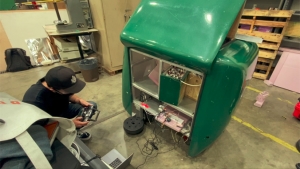Autonomous delivery vehicles are quickly becoming a reality worldwide, and, due to their touchless capability, their need has only escalated during the COVID-19 pandemic. One example is autonomous pizza delivery vehicles. Earlier this year, Domino’s partnered with Nuro to offer the service in Houston, Texas. Nuro’s R2 robot is the first completely autonomous, occupantless on-road delivery vehicle with regulatory approval by the U.S. Department of Transportation.
Soon, the University of Hawaiʻi at Mānoa may have its own fully-autonomous delivery vehicle thanks to a project by College of Engineering students. Members of UH Parcel Service (UHPS) have created a wireless prototype delivery vehicle capable of traveling up to four miles per hour, carrying a load of up to 300 pounds, traversing up inclines of 15 degrees (more than most wheelchair ramps) and delivering and receiving packages. While the prototype is able to travel in straight lines and make turns autonomously, programming it to travel across the UH Mānoa campus will be the task for next year’s team.
Daryll Suyat, a spring 2021 mechanical engineering graduate, served as the 2020–21 UHPS project manager. He oversaw the four subsystem teams: structure, powertrain/steering, autonomy and electrical.
“You have a bunch of different metals you welded into a frame, and a bunch of wires, a bunch of different components and being able to see it run and run fairly well was a great experience for me,” Suyat said.
Challenges posed by COVID-19

UHPS overcame many challenges presented by the COVID-19 pandemic, including getting accustomed to virtual meetings and finding time to safely meet in person to test out their prototype.
“During the first semester (fall 2020), we mainly did planning and designing so we used Zoom as our primary platform for our communication,” said Roxanne Balanay, UHPS electrical lead and spring 2021 mechanical engineering graduate. “However, for the second semester (spring 2021), we were heavily involved in manufacturing, implementing and integrating our designs so we had to meet in person. We had to schedule time slots to work at the mechanical engineering shop and we were only limited to five students at a time.”
Balanay added, “Since there were multiple senior design teams, there were times we didn’t get our preferred time and date so this prevented us from doing more testing. Despite the pandemic, our team managed to work together.”
Project inception

UHPS is part of a Vertically Integrated Project (VIP) called Autonomous Electric Vehicle System. UH Mānoa has more than a dozen VIPs, which are uniquely designed to include faculty mentors, graduate student researchers and undergraduates, from freshmen to seniors. The more experienced members mentor newer members, passing down their knowledge and expertise, and the process repeats itself annually. The team comprises two separate groups: VIP students and students from a Department of Mechanical Engineering senior design course.
Started in 2018, UHPS was tasked with creating an autonomous delivery vehicle to reduce the use of fossil fuels, and to make the delivery of products more cheaper and efficient. Then during the COVID-19 pandemic, Suyat said the need for contactless deliveries grew exponentially. After making it fully autonomous next year, Suyat hopes future teams will be able to replicate the designs and produce multiple autonomous vehicles for use across the UH Mānoa campus.
UHPS received nearly $5,000 of funding for the project from the College of Engineering and the UH Mānoa Undergraduate Research Opportunities Program.
This program is an example of UH Mānoa’s goals of Excellence in Research: Advancing the Research and Creative Work Enterprise (PDF), Building a Sustainable and Resilient Campus Environment: Within the Global Sustainability and Climate Resilience Movement (PDF) and Enhancing Student Success (PDF), three of four goals identified in the 2015–25 Strategic Plan (PDF), updated in December 2020.
—By Marc Arakaki

